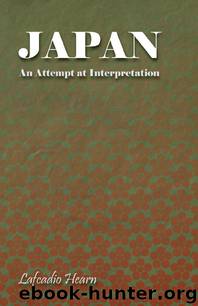Japan: An Attempt at Interpretation by Lafcadio Hearn

Author:Lafcadio Hearn [Hearn, Lafcadio]
Language: eng
Format: epub
Published: 0101-01-01T00:00:00+00:00
THE RISE OF THE MILITARY POWER
Almost the whole of authentic Japanese history is comprised in one vast episode: the rise and fall of the military power…. It has been customary to speak of Japanese history as beginning with the accession of Jimmu Tenno, alleged to have reigned from 660 to 585 B.C., and to have lived for one hundred and twenty-seven years. Before the time of the Emperor Jimmu was the Age of the Gods,—the period of mythology. But trustworthy history does not begin for a thousand years after the accession of Jimmu Tenno; and the chronicles of those thousand years must be regarded as little better than fairy-tales. They contain records of fact; but fact and myth are so interwoven that it is difficult to distinguish the one from the other. We have legends, for example, of an alleged conquest of Korea in the year 202 A.D., by the Empress Jingo; and it has been tolerably well proved that no such conquest took place.* [*See Aston’s paper, Early Japanese History, in the translations of the Asiatic Society of Japan.] The later records are somewhat less mythical than the earlier. We have traditions apparently founded on fact, of Korean immigration in the time of the fifteenth ruler, the Emperor Ojin; then later traditions, also founded on fact, of early Chinese studies in Japan; then some vague accounts of a disturbed state of society, which appears to have continued through the whole of the fifth century. Buddhism was introduced in the middle of the century following; and we have record of the fierce opposition offered to the new creed by a Shinto faction, and of a miraculous victory won by the help of the Four Deva Kings, at the prayer of Shotoku Taishi,—the great founder of Buddhism, and regent of the Empress Suiko. With the firm establishment of Buddhism in the reign of that Empress (593-628 A.D.), we reach the period of authentic history, and of the thirty-third Japanese sovereign counting from Jimmu Tenno.
But although everything prior to the seventh century remains obscured for us by the mists of fable, much can be inferred, even from the half-mythical records, concerning social conditions during the reigns of the first thirty-three Emperors and Empresses. It appears that the early Mikado lived very simply—scarcely better, indeed, than their subjects. The Shinto scholar Mabuchi tells us that they dwelt in huts with mud walls and roofs of shingle; that they wore hempen clothes; that they carried their swords in simple wooden scabbards, bound round with the tendrils of a wild vine; that they walked about freely among the people; that they carried their own bows and arrows when they went to hunt. But as society developed wealth and power, this early simplicity disappeared, and the gradual introduction of Chinese customs and etiquette effected great changes. The Empress Suiko introduced Chinese court-ceremonies, and first established among the nobility the Chinese grades of rank. Chinese luxury, as well as Chinese learning, soon made its appearance at court; and thereafter the imperial authority appears to have been less and less directly exerted.
Download
This site does not store any files on its server. We only index and link to content provided by other sites. Please contact the content providers to delete copyright contents if any and email us, we'll remove relevant links or contents immediately.
| Confucianism | Feng Shui |
| I Ching | Jainism |
| Karma | Shintoism |
| Sikhism | Tao Te Ching |
| Taoism | Tibetan Book of the Dead |
| Zoroastrianism |
The Tao of Physics by Fritjof Capra(1861)
The Diamond Cutter by Geshe Michael Roach(1675)
Feng Shui by Stephen Skinner(1622)
Human Design by Chetan Parkyn(1582)
The Alchemy of Sexual Energy by Mantak Chia(1496)
Tao Te Ching by Lao Tzu(1489)
365 Tao: Daily Meditations by Ming-Dao Deng(1307)
Tao Tantric Arts for Women by Minke de Vos(1267)
Sun Tzu's The Art of War by Giles Lionel Minford John Tzu Sun(1249)
Karma-Yoga and Bhakti-Yoga by Swami Vivekananda(1234)
Sidney Sheldon (1982) Master Of The Game by Sidney Sheldon(1193)
Buddhism 101 by Arnie Kozak(1188)
The Analects of Confucius by Burton Watson(1149)
The Art of War Other Classics of Eastern Philosophy by Sun Tzu Lao-Tzu Confucius Mencius(1146)
The New Bohemians Handbook by Justina Blakeney(1106)
Tao te ching by Lao Tzu(1081)
The Way of Chuang Tzu by Thomas Merton(1074)
The Sayings Of by Confucius(1032)
Bless This House by Donna Henes(993)
